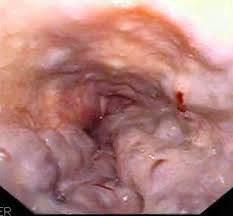Esophageal varices are swollen blood vessels in the esophagus, often caused by increased pressure in the veins of the liver. They can lead to serious complications if they rupture. Here are 20 signs and symptoms, 20 potential causes, 20 effects, and solutions related to esophageal varices:
**Signs and Symptoms:**
1. Hematemesis: Vomiting blood, often dark or resembling coffee grounds.
2. Melena: Tarry or dark stools due to bleeding.
3. Hematochezia: Passing bright red blood in bowel movements.
4. Epigastric Pain: Discomfort or pain in the upper abdomen.
5. Anemia: Low red blood cell count from blood loss.
6. Fatigue: Feeling weak or tired.
7. Pale Skin: Paleness due to anemia.
8. Dizziness: Feeling lightheaded or faint.
9. Rapid Heartbeat: Tachycardia due to blood loss.
10. Low Blood Pressure: Hypotension from significant bleeding.
11. Ascites: Accumulation of fluid in the abdomen.
12. Enlarged Spleen: Splenomegaly due to portal hypertension.
13. Jaundice: Yellowing of the skin and eyes.
14. Abdominal Swelling: Due to fluid retention.
15. Difficulty Swallowing: Odynophagia or dysphagia.
16. Nausea: Feeling sick to the stomach.
17. Vomiting: Forceful and recurrent vomiting.
18. Loss of Appetite: Reduced desire to eat.
19. Confusion: Altered mental state due to bleeding.
20. Syncope: Fainting episodes.
**Causes:**
1. Liver Cirrhosis: The most common cause, leading to increased pressure in liver veins.
2. Alcoholic Liver Disease: Excessive alcohol consumption can cause cirrhosis.
3. Hepatitis: Chronic viral hepatitis infections can lead to cirrhosis.
4. Portal Hypertension: Increased blood pressure in the portal vein.
5. Budd-Chiari Syndrome: Obstruction of the hepatic veins.
6. Schistosomiasis: A parasitic infection causing liver damage.
7. Hemochromatosis: Iron buildup in the liver.
8. Wilson's Disease: A genetic disorder affecting copper metabolism.
9. Primary Biliary Cirrhosis: An autoimmune liver disease.
10. Primary Sclerosing Cholangitis: A progressive liver disease.
11. Biliary Atresia: Congenital bile duct abnormalities.
12. Polycystic Liver Disease: Multiple liver cysts.
13. Nonalcoholic Fatty Liver Disease (NAFLD): Fat accumulation in the liver.
14. Thrombosis: Blood clot formation in liver veins.
15. Gastric Varices: Varices in the stomach.
16. Splenic Vein Thrombosis: Obstruction of the splenic vein.
17. Inherited Blood Disorders: Conditions like hereditary hemorrhagic telangiectasia (HHT).
18. Hepatic Vein Stenosis: Narrowing of the hepatic veins.
19. Liver Cancer: Tumors can disrupt blood flow.
20. Cirrhotic Nodules: Abnormal liver tissue formation.
**Effects:**
1. Gastrointestinal Bleeding: Ruptured varices can cause severe bleeding.
2. Hypovolemic Shock: Life-threatening drop in blood volume.
3. Hemodynamic Instability: Unstable vital signs due to bleeding.
4. Anemia: Low red blood cell count from blood loss.
5. Hepatic Encephalopathy: Brain dysfunction due to liver disease.
6. Ascites: Fluid buildup in the abdomen.
7. Hepatorenal Syndrome: Kidney dysfunction due to liver failure.
8. Organ Failure: Liver and kidney failure can occur.
9. Portal Hypertension Complications: Such as splenomegaly.
10. Coagulation Disorders: Blood clotting abnormalities.
11. Malnutrition: Inadequate nutrient intake due to bleeding.
12. Confusion and Delirium: Altered mental state.
13. Syncope: Fainting episodes.
14. Esophageal Strictures: Narrowing of the esophagus from scarring.
15. Infection: Risk of infections from bleeding.
16. Reduced Quality of Life: Due to symptoms and complications.
17. Reduced Mobility: Difficulty moving due to ascites.
18. Cardiovascular Issues: Increased strain on the heart.
19. Kidney Damage: Due to hepatorenal syndrome.
20. Death: Without prompt treatment, bleeding can be fatal.
**Solutions:**
1. Endoscopic Therapy: Procedures to stop bleeding and band varices.
2. Medications: Beta-blockers or vasoconstrictors to reduce bleeding risk.
3. Transjugular Intrahepatic Portosystemic Shunt (TIPS): A shunt to divert blood flow.
4. Sclerotherapy: Injection of a chemical to close off varices.
5. Balloon Tamponade: Use of a balloon to compress bleeding varices.
6. Portacaval Shunt: Surgical procedure to reroute blood flow.
7. Liver Transplantation: For severe liver damage.
8. Fluid and Blood Transfusions: To replace lost fluids and blood.
9. Coagulation Therapy: Correction of clotting abnormalities.
10. Nutritional Support: Ensuring proper nutrition during recovery.
11. Diuretics: To manage ascites.
12. Antibiotics: Preventing infections.
13. Hepatic Encephalopathy Management: Lactulose and other medications.
14. Hypertension Management: Blood pressure control.
15. Regular Monitoring: Ongoing assessment and treatment.
16. Lifestyle Changes: Alcohol cessation and dietary modifications.
17. Mental Health Support: Managing the emotional impact.
18. Blood Pressure Medications: To reduce portal hypertension.
19. Variceal Banding Surveillance: Regular follow-up endoscopies.
20. Early Intervention: Prompt treatment of underlying liver diseases.
Management of esophageal varices requires careful monitoring and treatment to prevent complications like bleeding, and it often involves collaboration between gastroenterologists and hepatologists.


